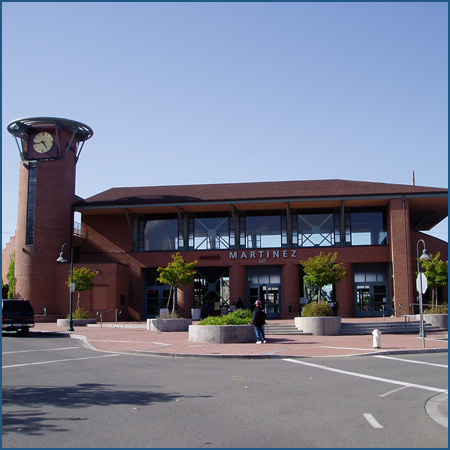()
In addition to a bright and airy passenger waiting room, the intermodal station, completed in 2001, houses the Martinez Visitors Center.

Annual Ticket Revenue (FY 2023): $8,065,681
Annual Station Ridership (FY 2023): 242,645
- Facility Ownership: City of Martinez
- Parking Lot Ownership: City of Martinez
- Platform Ownership: Union Pacific Railroad
- Track Ownership: Union Pacific Railroad
Alex Khalfin
Regional Contact
governmentaffairsoak@amtrak.com
For information about Amtrak fares and schedules, please visit Amtrak.com or call 1-800-USA-RAIL (1-800-872-7245).
The station in Martinez was built in 2001. Part of a larger 12-year construction project, the facility cost $31 million, paid for by the Contra Costa Transportation Authority, Bay Area Rapid Transit (BART), Caltrans, the California Transportation Commission, Union Pacific Railroad, the Federal Highway Administration and the Bay Area Quality Management District.
This intermodal facility features architecture reminiscent of old fashioned train stations with high ceilings and canopied benches. There is a balcony overlooking the three tracks and an 800-foot platform. The station provides parking for 160 vehicles and has bicycle lockers, ten bus bays, carpool and vanpool lots and provides a shuttle to the Martinez waterfront and downtown. The previous station, built in 1876, could not handle the amount of passengers using the station. Along with constructing the station itself, the project included the building of a mini-park, a walking trail and a flood control and restoration project along Alhambra Creek. In 2002, the design of the Martinez station was awarded the Merit Award for Intermodal Transportation Facilities in Excellence in Highway Design Awards.
The station also houses the Martinez Visitors’ Center, operated by the Martinez Chamber of Commerce from one end of the facility at 603 Marina Vista Avenue. In 2003, the city of Martinez constructed a memorial to those who died in the 9/11 attacks. The September 11 Memorial includes two pieces of steel girder from the World Trade Center, and stands close to the station, just outside the Visitors’ Center.
Martinez, located in the Alhambra Valley, was originally home to the Karkines Indians. In 1824, a land grant, including the Alhambra Valley, was given to Don Ygnacio Martinez, the Spanish governor of the area. The grant was a gift from the Mexican government thanking Martinez for his service in the Mexican army.
In 1847, Dr. Robert Semple of Kentucky, a lieutenant in California’s Bear Flag Revolt, began a ferry service across the Carquinez Strait between Benicia and Martinez. The ferry service catered to participants in the Gold Rush, as it was one of the only ways from San Francisco to the gold fields. Colonel M. Smith, seeing that business with gold miners and suppliers was beneficial, made an agreement with the family of Ygnacio Martinez to establish a town site at the ferry crossing. In 1851, the California Legislature named Martinez as the county seat and it was incorporated in 1876. Agriculture was the major economic business of Martinez and was aided by the arrival of the Central Pacific Railroad in 1877. Martinez became a stop on the transcontinental route and a transfer point between the Shasta and Coastal routes.
Martinez is the birth place of Joe DiMaggio and the last home of John Muir, the famous naturalist and conservationist who, in the 1890s, was instrumental in the creation of Yosemite National Park and the establishment of the Sierra Club. This city is also said to the birthplace of the Martini drink.
The San Joaquins service is primarily financed through funds made available by the State of California, Department of Transportation, and is managed by the San Joaquin Joint Powers Authority. The Capitol Corridor route is primarily financed and operated in partnership with the State of California. It is managed by the Capitol Corridor Joint Powers Authority (CCJPA), which partners with Amtrak, the Union Pacific Railroad, Caltrans and the communities comprising the CCJPA to continue development of a cost-effective, viable and safe intercity passenger rail service.
Features
- ATM not available
- No elevator
- No payphones
- No Quik-Trak kiosks
- No Restrooms
- Unaccompanied child travel not allowed
- No vending machines
- No WiFi
- Arrive at least minutes prior to departure
Baggage
- Amtrak Express shipping not available
- No checked baggage service
- No checked baggage storage
- Bike boxes not available
- No baggage carts
- Ski bags not available
- No bag storage
- Shipping boxes not available
- No baggage assistance
Parking
Accessibility
- No payphones
- No accessible restrooms
- No accessible ticket office
- No accessible waiting room
- No accessible water fountain
- No high platform
- No wheelchair
- No wheelchair lift
Hours


 Amtrak established the Great American Stations Project in 2006 to educate communities on the benefits of redeveloping train stations, offer tools to community leaders to preserve their stations, and provide the appropriate Amtrak resources.
Amtrak established the Great American Stations Project in 2006 to educate communities on the benefits of redeveloping train stations, offer tools to community leaders to preserve their stations, and provide the appropriate Amtrak resources. For more than 50 years, Amtrak has connected America and modernized train travel. Offering a safe, environmentally efficient way to reach more than 500 destinations across 46 states and parts of Canada, Amtrak provides travelers with an experience that sets a new standard. Book travel, check train status, access your eTicket and more through the
For more than 50 years, Amtrak has connected America and modernized train travel. Offering a safe, environmentally efficient way to reach more than 500 destinations across 46 states and parts of Canada, Amtrak provides travelers with an experience that sets a new standard. Book travel, check train status, access your eTicket and more through the